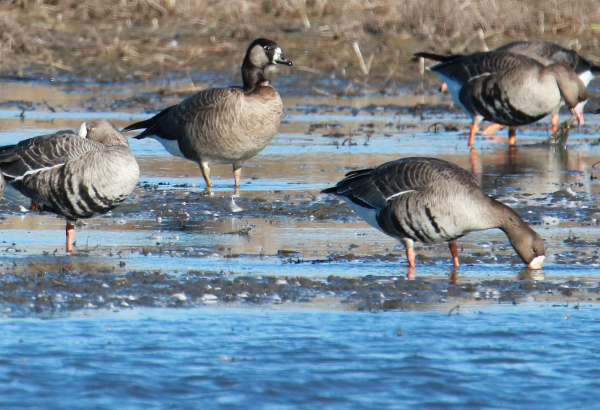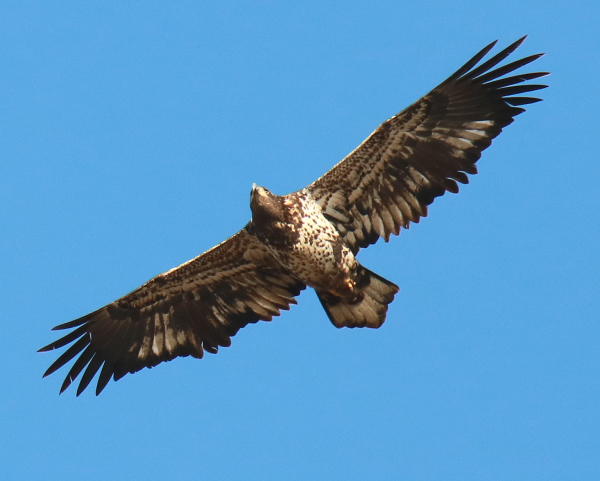
A concentration of Snow Geese has built up from 1,000 to nearly 5,000 less than 2 miles from home. Associated with the Snows are scattered Ross’s Geese, along with flocks of White-fronted Geese, Cackling Geese, and Canada Geese – 5 species in all.

A unique super-rare hybrid between 2 Arctic-nesting species – a Cackling Goose and a White-fronted Goose – was found among a flock of 120 White-fronts. You can read more about it in this week’s Bird Photography article.

An immature Bald Eagle glided overhead during our riverside walk.

The first Rough-legged Hawk of the season, a light-colored male with a somewhat unique coloration.
|
After passing by an active flock of more than a thousand Snow Geese feeding in a harvested roadside cornfield, I pulled over when I was surprised by an interesting flock of about 120 White-fronted Geese on the edge of a marsh on the other side of the road. The geese quickly relaxed as I parked in relatively close quarters with beautiful early afternoon sunlight in my favor, while the pleasant calls of the White-fronts added flavor to the photo setting. A lone Giant Canada Goose and a couple Mallards provided a size scale for the White-fronts, but another goose really stood out!
At first I thought it was a Cackling Goose, as its head and size suggested, but its cheeks were colored tan rather than the bright white of Cacklers, and the feathers between its bill and eyes were white – like the White-fronted Geese that surrounded it. But Cackling Geese don’t have white plumage surrounding the base of their bill. And this goose’s legs and feet were yellow (Cackling Geese have black legs; White-fronts have orange legs and feet); and its bill was gray with a black outline (Cackling Geese have a black bill; adult White-fronts have an orange or pink bill). No doubt in my mind, this unique bird is a super-rare hybrid between 2 Arctic-nesting species – a Cackling Goose and a White-fronted Goose. I got photos – prove me wrong.
Earlier that day I spent some time too far away from the expansive flock of about 3,000 geese but reveled at the goose music that filled the air. The flock covered more than ¾ of a mile from north to south; mostly composed of Snow Geese, along with some flocks of White-fronts. Finally I was able to pick out a few Ross’s Geese mixed among the Snows, and the first Cackling Geese of this fall mixed in with Canadas on the south end of the giant corn feast. That made it official, there were 5 species of geese here now – plus a rare hybrid!
Wednesday with Vicki
I enjoyed starting my week of birding in Bismarck last Wednesday with my dear friend Vicki as we hiked 2 fun locations, beginning at Sleepy Hollow on a trail covered by oak leaves that provided a different and enticing habitat for both of us as it led to the top of a tall prairie hill. It made me remember walking out to Sleepy Hollow and Hay Creek after grade school years ago when the area was beyond the east edge of town. From there we covered the north side of the area with little luck at finding the ground-oriented birds I hoped to find – Dark-eyed Juncos, Harris’s Sparrows and other native sparrows that might have included a Fox Sparrow, but we were left inspecting an abundance of woodpecker cavities in a number of oak branches along our route instead.
As we considered our next move, Vicki suggested we try her favorite hiking trail that skirts the edge of the Missouri River on the other side of the city. It provided a refreshing look at a long-familiar area that has matured from a huge sandbar over decades to nourish willow beds, young cottonwoods, natural ponds, and water channels that harbored beavers among other animals. Ring-billed Gulls were abundant overhead, but our interest level spiked when I spied a distant Bald Eagle that we could see was a “white-belly” immature bird 2 or 3 years old. And moments later a similar Bald Eagle soared toward our position, eventually passing directly above us, providing a quick opportunity to take a few photos.
After we transitioned from the riverside to the gallery forest of towering cottonwoods with willow and grass undergrowth, I was surprised by a Black-capped Chickadee as it flew perpendicular to our advance and perched in a Russian olive tree nearby, voicing its tell-tale “chickadee-dee-dee.” I explained to Vicki that I hadn’t seen or heard a chickadee for some months – since I was birding north of Minneapolis with my niece Katy – due to the fact they no longer inhabit my home region. (It seems chickadees were probably eliminated by West Nile Virus about 17 years ago – chickadees and crows seemed to be especially affected.) A Blue Jay sighting finished off our duo of hikes, and we opted for a light dinner next.
On my way to Bismarck that day I observed few birds compared to recent weeks: There were far fewer Red-tailed Hawks along the way, and no eagles – Bald or Goldens. I did see an American Kestrel not far from home though, and scattered flocks of ducks along the first 1/3 of the drive. The theme of fewer birds in the region was even more extreme Friday when I checked my usual haunts: There were NO Red-tails, a single Northern Harrier, an adult Bald Eagle, and a first of fall Rough-legged Hawk – a rather uniquely colored male with considerable light-rufous highlights on its underside. I was able to photograph the interesting raptor that originated from the Arctic as it hovered almost overhead before continuing in a southbound flight path across an expansive prairie.
Feeder Switch
I finally took my hummingbird feeder down after the long-range hope of attracting a far-offcourse late-season Rufous Hummingbird, but hesitated to replace it with my seed feeder yet. I hadn’t seen any seed-eating specialists migrate into the area to date, and didn’t want to attract a bunch of “undesirables” – starlings, grackles, House Sparrows. But Sunday, the first Pine Siskin arrived, and when another appeared at my bird bath I decided the time was right. I promptly filled my SquirrelBuster tube feeder with a mix of shelled seeds – primarily black oil sunflower seeds with peanut parts (the 3D Zero-Waste Deck Porch ‘n Patio Wild Bird Mix). It’s a mix I appreciate for its value to birds and a no-shell mess-less option.
Immediately, Pine Siskins and White-breasted Nuthatches grabbed some seeds, followed by previously unseen American Goldfinches and male and female House Finches. It was fun to see such immediate attention, and the siskins, goldfinches, and finches all utilized the fresh water in the bird bath too. Downy and Hairy Woodpeckers continued to feed on the no-melt hot chili suet, but the nuthatches preferred the seeds. Quietly a Blue Jay arrived, checked out the feeding station from 3 different perches, but didn’t go to a feeder or the bird bath. The following day a Blue Jay, or more than one, fed on peanuts and seeds a number of times, and up to 4 Pine Siskins at a time utilized the seeds.
So in my yard, on Halloween the transition to a late fall and winter feeding strategy was initiated with a new level of excitement outside my bay windows – excellent! What interesting birds will follow? The November birding thrills have begun!
Article and photos by Paul Konrad
Share your bird sightings and photographs at editorstbw2@gmail.com